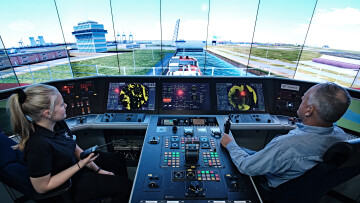
FUI-Bloggen
FUI är förkortningen för forskning, utveckling och innovation. I FUI-bloggen skriver Yrkeshögskolan Novias personal om sitt jobb, forskning, projektverksamhet och andra betraktelser.
Blogginlägg som är granskat av Novias redaktionsråd är utmärkta med nyckelordet "Granskat inlägg".
Vi följer CC-BY 4.0 om inget annat nämns.
Can you think without words?

Reports on maritime accidents that give communication as a contributory cause for the accident, often show that it is lack of communication rather than faulty communication that has been the problem. In other words: someone has not had a strong enough intention to say something. Crewmembers, pilots, or equivalent, have either (actively) chosen to stay silent, or simply (passively) not experienced a need to communicate.
The Digimar project works with VTS communication. One aim with the project is to create digital learning materials for the maritime industry, thus the name of the project: Digital Education for Maritime Communication. To begin with the project studied accident reports describing accidents involving a communication related ingredient. The results might reveal a hint of intellectual laziness in that the reports do not define communication in detail. A communication problem might be connected to language competence, to a cultural component (including the assertiveness-discussion), interpersonal issues, or for example to personal variables (fatigue, training, education, and competence). If we do not address the question about what we mean by communication problems, we might prescribe wrong medicine, provide inefficient education for communication difficulties. Consider for example the persistent complaint within (all?) work organizations; “communication should be improved”. What, and where, would you begin to improve?
The grounding of the Hamburg in 2015 (pp.35-36) may serve as an example of the confusion described above. The communication onboard at the time of the grounding is described with words such as confusing, weakness, and “very little information flow or discussion”. The report further demonstrates weaknesses in procedures and bridge team management. Amid the mentioned functions, hovers “communication”, but it is difficult to say what aspect of communication should be remedied. There are probably many aspects to address, and one connected question is – should they be approached separately or as a whole? Would it not be possible that a missing intention derives in a team member being totally unaware of a need to verbalize thoughts. The ignorance could be a result of the onboard culture. The officer of the watch (or pilot? Or master?) may experience that s/he is responsible and thus must manage the work on his own. Someone else on the bridge might experience the opposite: “I am not responsible – I don’t have to think” (“Mä oon tääl vaan töis” = Finnish for “I only work here”, describing a passive attitude). Either way, verbalizing perceived voids could be an important skill to develop, to improve communication.
The Digimar project will work further with VTS communication. It will be interesting to see whether voids in communication are identified and whether VTSOs could be of help in verbalizing them for the bridge teams. If accidents happen because of silence, silence should be broken. And if navigators do not know how to break the silence, it must be learned. Navigators must not remain in a situation best described with Wittgenstein’s words: “Whereof one cannot speak – thereof one must be silent”.
Peter Björkroth, Senior Lecturer e.g., in communication
The blogpost has been reviewed by Novia's editorial board and accepted for publication on 20.5.2024.
![]()
FUI-Bloggen
Blogginlägg som är granskat av Novias redaktionsråd är utmärkta med nyckelordet "Granskat inlägg".
Vi följer CC-BY 4.0 om inget annat nämns.
Ansvarsfriskrivning: Författaren/författarna ansvarar för för fakta, möjlig utebliven information och innehållets korrekthet i bloggen. Texterna har genomgått en granskning, men de åsikter som uttrycks är författarens egna och återspeglar inte nödvändigtvis Yrkeshögskolan Novias ståndpunkter.
Disclaimer: The author(s) are responsible for the facts, any possible omissions, and the accuracy of the content in the blog.The texts have undergone a review, however, the opinions expressed are those of the author and do not necessarily reflect the views of Novia University of Applied Sciences.
Posta din kommentar
Kommentarer
Inga har kommenterat på denna sida ännu